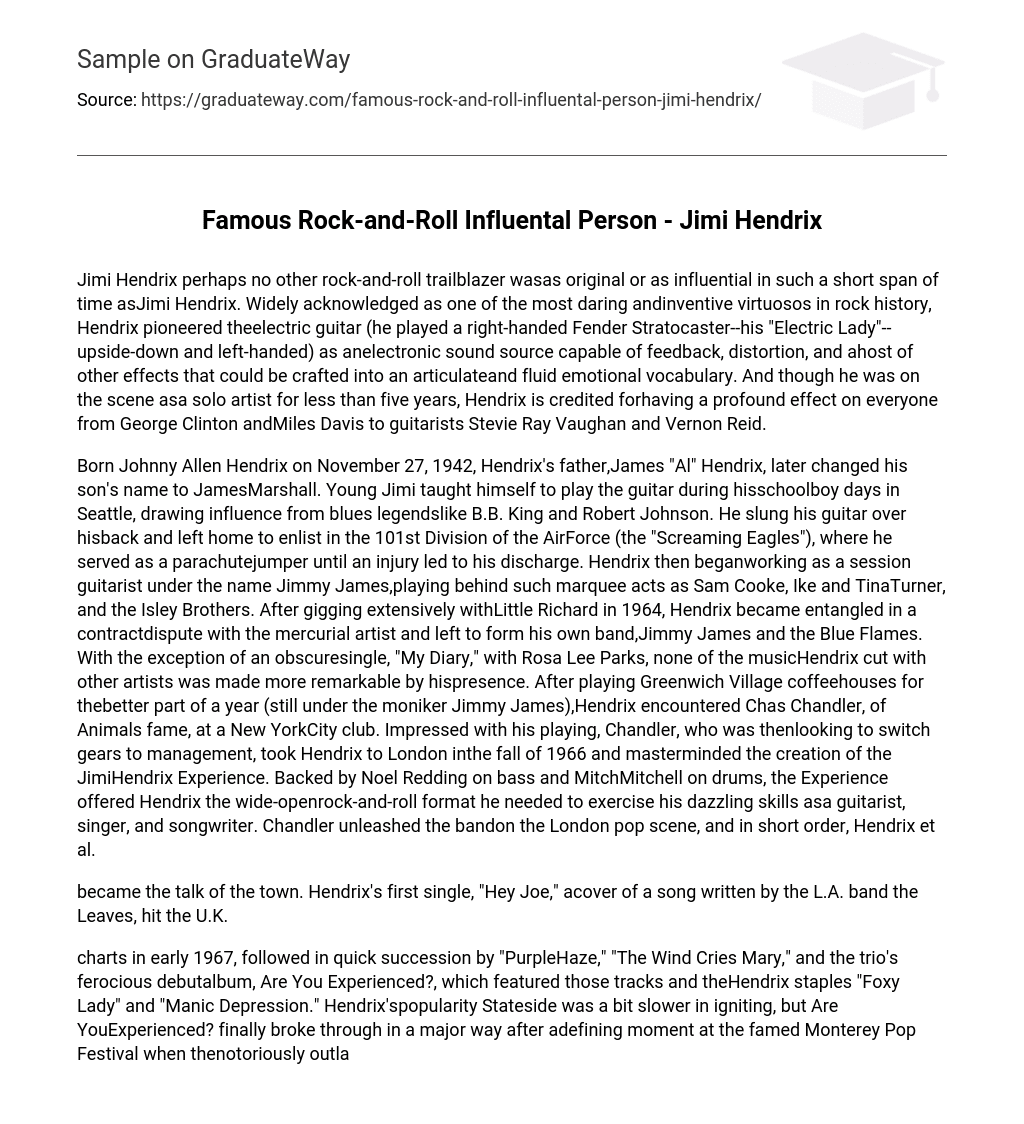Jimi Hendrix perhaps no other rock-and-roll trailblazer wasas original or as influential in such a short span of time asJimi Hendrix. Widely acknowledged as one of the most daring andinventive virtuosos in rock history, Hendrix pioneered theelectric guitar (he played a right-handed Fender Stratocaster–his “Electric Lady”–upside-down and left-handed) as anelectronic sound source capable of feedback, distortion, and ahost of other effects that could be crafted into an articulateand fluid emotional vocabulary. And though he was on the scene asa solo artist for less than five years, Hendrix is credited forhaving a profound effect on everyone from George Clinton andMiles Davis to guitarists Stevie Ray Vaughan and Vernon Reid.
Born Johnny Allen Hendrix on November 27, 1942, Hendrix’s father,James “Al” Hendrix, later changed his son’s name to JamesMarshall. Young Jimi taught himself to play the guitar during hisschoolboy days in Seattle, drawing influence from blues legendslike B.B. King and Robert Johnson. He slung his guitar over hisback and left home to enlist in the 101st Division of the AirForce (the “Screaming Eagles”), where he served as a parachutejumper until an injury led to his discharge. Hendrix then beganworking as a session guitarist under the name Jimmy James,playing behind such marquee acts as Sam Cooke, Ike and TinaTurner, and the Isley Brothers. After gigging extensively withLittle Richard in 1964, Hendrix became entangled in a contractdispute with the mercurial artist and left to form his own band,Jimmy James and the Blue Flames. With the exception of an obscuresingle, “My Diary,” with Rosa Lee Parks, none of the musicHendrix cut with other artists was made more remarkable by hispresence. After playing Greenwich Village coffeehouses for thebetter part of a year (still under the moniker Jimmy James),Hendrix encountered Chas Chandler, of Animals fame, at a New YorkCity club. Impressed with his playing, Chandler, who was thenlooking to switch gears to management, took Hendrix to London inthe fall of 1966 and masterminded the creation of the JimiHendrix Experience. Backed by Noel Redding on bass and MitchMitchell on drums, the Experience offered Hendrix the wide-openrock-and-roll format he needed to exercise his dazzling skills asa guitarist, singer, and songwriter. Chandler unleashed the bandon the London pop scene, and in short order, Hendrix et al.
became the talk of the town. Hendrix’s first single, “Hey Joe,” acover of a song written by the L.A. band the Leaves, hit the U.K.
charts in early 1967, followed in quick succession by “PurpleHaze,” “The Wind Cries Mary,” and the trio’s ferocious debutalbum, Are You Experienced?, which featured those tracks and theHendrix staples “Foxy Lady” and “Manic Depression.” Hendrix’spopularity Stateside was a bit slower in igniting, but Are YouExperienced? finally broke through in a major way after adefining moment at the famed Monterey Pop Festival when thenotoriously outlandish frontman created a sensation by coaxingflames from his Strat during the band’s performance. The nextyear, Hendrix’s eclectic psychedelia reached a zenith with twoalbums, Axis: Bold As Love and Electric Ladyland–the latterranks as one of the greatest works of the rock era.
But the experience at the top didn’t last long– Hendrix andbassist Redding grew apart, and muddled by overindulgence indrugs and groupies, Hendrix came to believe–wrongly–that hismanagement was cheating him. In 1969, the Experience disbanded.
In the summer of 1969, Hendrix played Woodstock with an informalensemble called the Electric Sky Church, in a performancehighlighted by another career-defining moment: a startling,renegade rendition of “The Star- Spangled Banner.” Hendrixsubsequently formed the Band of Gypsys, with old Air Force friendBilly Cox on bass and Buddy Miles (Electric Flag) on drums. Theband’s New Year’s Eve concert at the Fillmore East in New YorkCity provided them with material for their first album, Band ofGypsys (more material from the show was released on Band ofGypsys 2 in 1986).
Hendrix brought Mitch Mitchell back into the fold in mid-1970 to begin work on a new double album Jimi had tentativelytitled First Rays of the New Rising Sun. Several tracks wererecorded for the project, but the sessions were sandwichedbetween tour dates, and, sadly, the album was left unfinishedwhen Hendrix died September 18, 1970. The cause of death noted onthe coroner’s report was inhalation of vomit after barbiturateintoxication. In 1993, the investigation into Hendrix’s death wasreopened by Scotland Yard, but when no new evidence wasunearthed, the matter was dropped. In 1971, several of the tracksintended for First Rays were compiled and released as The Cry ofLove, and the ensuing years have witnessed a flood of releases ofHendrix tributes, books, videos, and albums, including pre-famebarrel-scrapings of Hendrix takes from his pickup guitarist days.
Posthumous releases took on new life in the CD era. In 1994, MCAreleased three Hendrix thematic compilations: one devoted toblues songs recorded between 1966 and 1970 (Jimi Hendrix: Blues),one to his live performance at Woodstock (Jimi Hendrix:Woodstock), and a third (Voodoo Soup) that represented an attemptto recreate Hendrix’s unfinished fourth studio album. In April of1997, yet another attempt was made to recreate the album Hendrixwas working on at the time of his death, but this time theproject was overseen by Hendrix co-producer Eddie Kramer andhistorian John McDermott–and it had the Hendrix family stamp ofapproval. The seventeen-track album, First Rays of the New RisingSun, is arguably the best assemblage of Hendrix leftovers so far.
Despite these transgressions against his nearly faultless musicallegacy and attempts to create what could have been, Hendrix’sinnovations and soul live on in the playing of every rock-and-roll guitarist.





